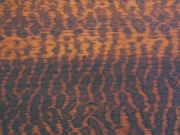Difference between revisions of "Snakewood"
Jump to navigation
Jump to search
JLBoutaine (talk | contribs) m (→Description) |
JLBoutaine (talk | contribs) |
||
| Line 6: | Line 6: | ||
== Synonyms and Related Terms == | == Synonyms and Related Terms == | ||
| − | ''Piratinera guianensis''; letterwood; letter wood; leopard wood; tortoiseshell wood; bois d'amourette (Fr.) | + | ''Piratinera guianensis''; letterwood; letter wood; leopard wood; tortoiseshell wood; bois d'amourette; bois de lettre (Fr.) |
{| class="wikitable" | {| class="wikitable" | ||
Revision as of 15:00, 14 December 2013
Description
A highly patterned wood obtained from Piratinera guianensis trees that are native to West Indies and northern regions of South America. Snakewood is heavy with a fine uniform texture. Although the grain is straight, the wood has a distinct yellow, dark red, and brown mottled pattern that resembles snakeskin. Snakewood was popluar for veneers in the late 18th century. The durable wood is still used for stringed instrument bows, veneers, walking sticks, and modeling tools.
Synonyms and Related Terms
Piratinera guianensis; letterwood; letter wood; leopard wood; tortoiseshell wood; bois d'amourette; bois de lettre (Fr.)
| Density | 80 ppcf |
|---|
Authority
- Ralph Mayer, A Dictionary of Art Terms and Techniques, Harper and Row Publishers, New York, 1969 (also 1945 printing)
- F. H. Titmuss, Commercial Timbers of the World, The Technical Press Ltd., London, 1965
- George Savage, Art and Antique Restorer's Handbook, Rockliff Publishing Corp, London, 1954
